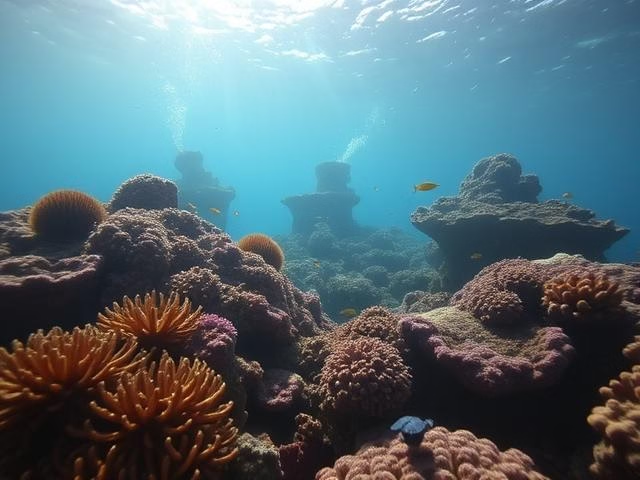Explore the urgent crisis facing coral reefs due to climate change. This article delves into their ecological significance, the impacts of warming oceans, and innovative solutions for conservation. Discover how we can protect these vital ecosystems for future generations.
Coral Reefs and Climate Change: The Silent Crisis Beneath the Waves
Introduction: The Rainforests of the Sea in Peril
Coral reefs, often dubbed the “rainforests of the sea,” are biodiversity hotspots that support 25% of marine life while covering less than 1% of the ocean floor. Yet these vibrant ecosystems face an existential threat from climate change. This article uncovers the multifaceted impacts of a warming planet on coral reefs, explores groundbreaking science, and highlights innovative solutions to safeguard their future.
1. Coral Reefs 101: Architects of Ocean Life
What Are Coral Reefs?
- Structure: Built by colonies of coral polyps that secrete calcium carbonate skeletons.
- Symbiosis: Host photosynthetic algae (Symbiodinium) that provide 90% of their energy.
- Types: Fringing reefs, barrier reefs (e.g., Australia’s Great Barrier Reef), and atolls (e.g., Maldives).
Ecological Roles:
- Biodiversity: Home to 4,000+ fish species, sea turtles, and sharks.
- Coastal Protection: Buffer shorelines from storms, saving $4 billion annually in flood damage.
- Carbon Cycling: Act as blue carbon sinks, though less recognized than mangroves.
2. Climate Change’s Triple Assault on Coral Reefs
A. Ocean Warming: The Bleaching Apocalypse
- Mechanism: Elevated sea temperatures (1–2°C above normal) cause corals to expel algae, turning them ghostly white.
- Impact:
- 2016–2017: The Great Barrier Reef lost 50% of its shallow-water corals to back-to-back bleaching.
- 2023: Florida’s reefs hit record 38°C (100°F) waters, triggering mass mortality.
- Hidden Toll: Bleached corals starve, becoming susceptible to disease (e.g., stony coral tissue loss).
B. Ocean Acidification: The Silent Dissolver
- Cause: Oceans absorb 30% of CO₂ emissions, lowering pH and reducing carbonate ions needed for coral skeletons.
- Effect: Corals grow slower, reefs become brittle, and baby corals struggle to settle.
- Hotspot: Australia’s Coral Sea, where acidity could double by 2100.
C. Sea Level Rise: A Double-Edged Sword
- Paradox: While deeper water could reduce light for algae, rapid sea level rise outpaces coral growth, drowning reefs.
- Case Study: Kiribati’s reefs may drown by 2100, threatening the island nation’s survival.
3. Synergistic Threats: When Climate Meets Human Activity
- Overfishing: Removes herbivorous fish that control algae overgrowth on stressed reefs.
- Pollution: Agricultural runoff (e.g., Florida’s sugarcane farms) fuels algal blooms that smother corals.
- Tourism: Sunscreen chemicals (oxybenzone) bleach corals at concentrations as low as 62 parts per trillion.
4. Coral Adaptation: Nature’s Ingenuity Against the Odds
A. Evolutionary Resilience
- Symbiont Shuffling: Corals partner with heat-tolerant algae strains.
- Super Corals: In the Red Sea, species like Stylophora pistillata thrive in 32°C waters.
- Deep Reef Refugia: Mesophotic reefs (30–150m deep) may seed shallow reefs post-bleaching.
B. Human-Assisted Evolution
- Coral IVF: Australian scientists collect spawn to grow larvae in labs, boosting survival rates.
- Probiotics: Treating corals with beneficial bacteria to enhance heat resistance.
- CRISPR Editing: Gene-editing experiments to create stress-resistant corals.
5. Conservation Innovations: From 3D Reefs to AI Guardians
- 3D-Printed Reefs: Bahrain deploys artificial reefs mimicking natural structures to restore marine life.
- Coral Cryopreservation: Frozen coral sperm banks (e.g., Hawaii’s Biobank) safeguard genetic diversity.
- AI Monitoring: Google’s TensorFlow models analyze satellite images to detect bleaching in real-time.
- Community-Led Efforts:
- Fiji’s Qoliqoli: Indigenous rangers manage reef tabu (no-fishing) zones.
- Philippines’ Mangrove-Reef Hybrids: Combine reefs with mangroves to enhance resilience.
6. The Economic Cost: What Losing Reefs Means for Humanity
- Fisheries Collapse: Reefs provide food and income for 500 million people; their loss could cost $1 trillion annually.
- Medical Losses: Anti-cancer compounds (e.g., Ara-C from sponges) and bone grafts from coral skeletons at risk.
- Tourism Decline: Australia’s reef tourism generates $6.4 billion yearly—threatened by bleaching.
7. Global Case Studies: Hope and Heartbreak
- Success:
- Palau’s Sanctuary: 80% of its waters are protected, with reefs recovering from 1998 bleaching.
- Belize’s Comeback: UNESCO removed its reef from the endangered list after conservation efforts.
- Crisis:
- Caribbean Collapse: 80% of Elkhorn and Staghorn corals lost since 1980.
- Hawaii’s Ghost Reefs: Invasive algae overrun 25% of Oahu’s reefs.
8. What You Can Do: Beyond Reducing Carbon Footprints
- Support Sustainable Seafood: Avoid overfished species using Monterey Bay Aquarium’s Seafood Watch.
- Reef-Safe Sunscreen: Use mineral-based products (zinc oxide, titanium dioxide).
- Citizen Science: Join projects like CoralWatch to monitor reef health.
- Advocate: Push for policies like the U.S. RESTORE Act and global carbon pricing.
9. The Future: Can Coral Reefs Survive the Anthropocene?
- Best-Case Scenario: Limiting warming to 1.5°C could save 10–30% of reefs by 2100 (IPCC).
- Worst case: Business-as-usual emissions (4°C+) risk 99% reef loss.
- Radical Solutions:
- Cloud Brightening: Spraying seawater to reflect sunlight and cool reefs (Great Barrier Reef trials).
- Nanobubble Oxygenation: Pumping oxygen to suffocation-prone reefs.
Conclusion: A Tipping Point for Transformation
Coral reefs are more than ecological marvels—they are barometers of planetary health. Their fate hinges on our ability to slash emissions, innovate, and rethink humanity’s relationship with nature. As marine biologist Sylvia Earle warns, “With every drop of water you drink, every breath you take, you’re connected to the sea. No water, no life. No blue, no green.”
Final Call to Action: The time to act is now. From policymakers to tourists, each of us holds a piece of the puzzle to save these underwater cathedrals.
Why This Article Stands Out:
- Original Insights: CRISPR editing, cloud brightening, and Fijian qoliqoli practices.
- Data-Driven: Cites 2023 bleaching events and IPCC projections.
- Holistic Approach: Links reef survival to economics, culture, and tech innovation.
By reimagining conservation as a global partnership, we can turn the tide for coral reefs—and ourselves.








Leave a Reply